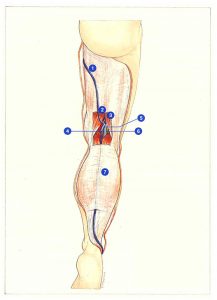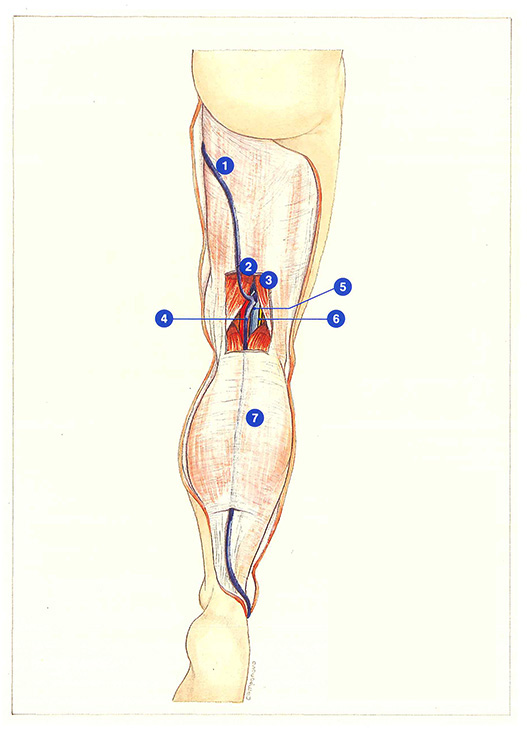General topography
The short saphenous vein, also called the small saphenous vein, is a continuation of the lateral marginal vein on the dorsal surface of the foot. At its origin, the main trunk passes underneath, then posteriorly to the lateral malleolus in the lateral retromalleolar sulcus. It then ascends vertically, in a median. suprafascial position, on the posterior surface of the calf, where it is adherent to the sural nerve (sensory). In two thirds of cases, the main trunk is accompanied by one or two accessory trunks: the first passes over the lateral malleolus. and the second lies one or two fingerbreadths above the lateral malleolus.
After reaching the origin of the tendo calcaneus, the main short saphenous trunk travels between the two tendons of the gastrocnemius muscle. Initially suprafascial, it then penetrates underneath the fascia which is particularly dense at this level. Continuing its ascension in the “gastrocnemial groove,” it reaches the popliteal fossa.
(Figure 72).
When the subject is standing. taking his or her weight on both legs, the subfascial location of the short saphenous vein makes it difficult to palpate in the popliteal fossa. Consequently. clinical investigation of the short saphenous vein is performed with the patient standing, with the leg in semiflexion and the foot resting on the tip of the toes. In this position, the weight of the body is borne by the other leg and the fascial tension on the short saphenous vein is released. The relationship between the quality of the fascial tension and the diameter of the vein can then be detected by the clinician.
The popliteal fossa is limited inferiorly by the lateral and medial bodies of the gastrocnemius muscle, superolaterally by the biceps femoris tendon, and superomedially by thesemitendinosus tendon. In the popliteal crease, the short saphenous vein often presents a palpable ampullary dilatation. It then runs moredeeply and describes an anterior concave arch before terminating in the popliteal vein at a variable level.
In the popliteal fossa, the short saphenous vein enters into contact with the sural nerve laterally and anteriorly and, more laterally, with the tibia] nerve. It also runs adjacent to lymph nodes on either side of the saphenopopliteal junction. Its arterial relations consist of the short saphenous artery and sural branches of the popliteal artery. The short saphenous artery is an inconstant branch of the popliteal artery, supplying the skin, while the sural branches can be responsible for necrosis of the gastrocnemius muscle following accidental injection of sclerosing agent.
More deeply, the short saphenous vein is related to the terminal trunks of the medial and lateral gastrocnemius veins and the popliteal vein, which is duplicated in 2000 of cases by a collateral channel in which the short saphenous vein may terminate.

Further reading
Davy A. L’anatomie normale des veines des membres inférieurs. Éditions Expansion Scientifique Française, Paris 1980.
Kahle W., Leonhardt H., Platzer W. Atlas d’anatomie humaine, tome 1. Éditions Flammarion Médecine Sciences, Paris 1978.
Sobotta. Atlas d’anatomie humaine, tome 2. Éditions Médicales Internationales, Paris 1986.
